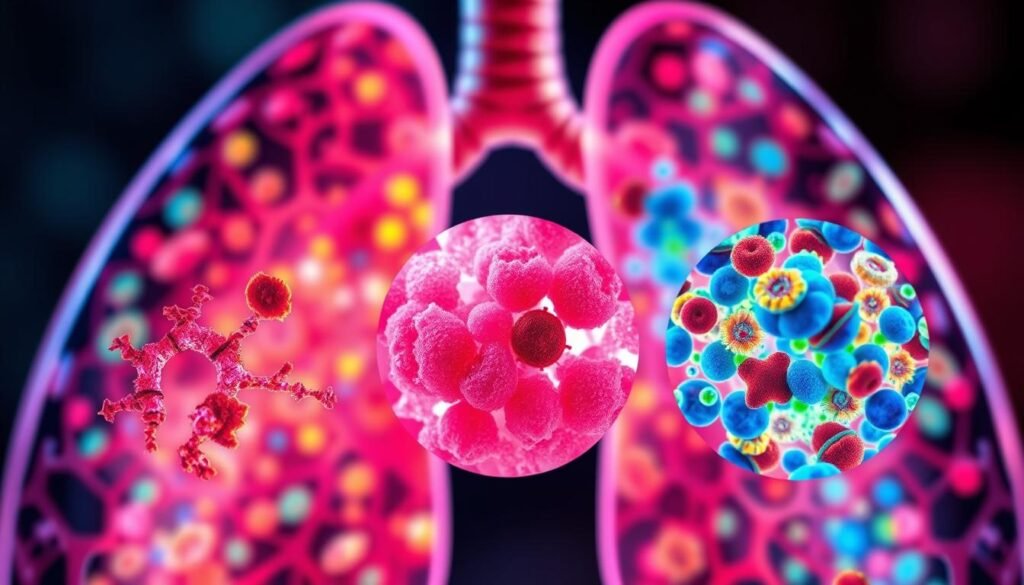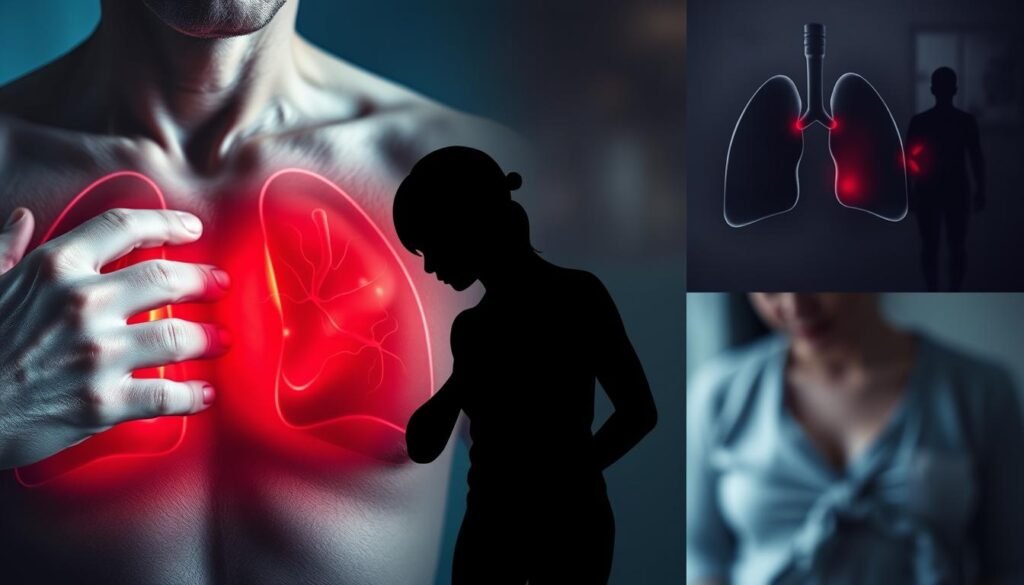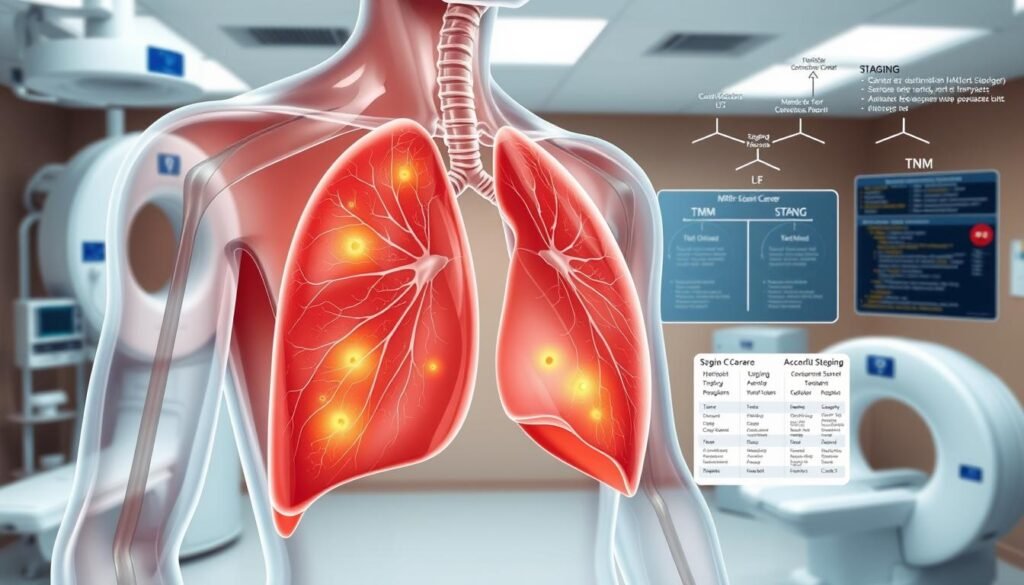Did you know that non-small cell lung cancer (NSCLC) makes up about 84% of all lung cancer cases? This high number shows how vital it is to find effective treatments. NSCLC starts in lung tissues and includes types like squamous cell carcinoma, adenocarcinoma, and large cell carcinoma. Knowing the treatment for non-small cell lung cancer is key. It changes depending on the cancer type, its stage, and the patient’s health.
This article looks at different lung cancer treatment options for NSCLC. We will discuss therapy choices and highlight new progress. This progress can greatly affect how well patients do. Getting all the facts helps in making smart choices on the journey to recovery.
Key Takeaways
- NSCLC comprises 84% of lung cancer cases, making it a critical health issue.
- Various types of NSCLC include squamous cell carcinoma, adenocarcinoma, and large cell carcinoma.
- Smoking is the leading risk factor for developing non-small cell lung cancer.
- Diagnosis requires advanced testing methods like CT scans and biopsies.
- Understanding treatment alternatives is essential for effective management of NSCLC.
Understanding Non-Small Cell Lung Cancer
Non-small cell lung cancer (NSCLC) makes up about 85% of lung cancer cases in the U.S. It starts in the epithelial cells of the bronchi and alveoli. This makes it different from the rarer small cell lung cancer.
NSCLC includes several types. Adenocarcinoma accounts for 40% of NSCLC cases. Squamous cell carcinoma is 25-30% of cases, and large cell carcinoma is 10-15%. NSCLC often grows without early symptoms, making early detection tough.
Smoking is a major risk factor for NSCLC. However, adenocarcinoma can also happen in non-smokers. It’s key for everyone to know about NSCLC for early detection and treatment.
Types of Non-Small Cell Lung Cancer
Non-small cell lung cancer (NSCLC) includes different cancer types that affect the lungs. It mainly involves adenocarcinoma, squamous cell carcinoma, and large cell carcinoma. Here’s a detailed look at these common forms:
- Adenocarcinoma: This is the most seen type, making up about 40% of lung cancer cases. It starts in the mucus-making glands of the airways and is usually found in non-smokers.
- Squamous Cell Carcinoma: It comprises about 25-30% of lung cancer cases, forming in the flat cells lining the lungs. This kind often occurs close to the lung’s center.
- Large Cell Carcinoma: Making up 5-10% of lung cancers, it features bigger, abnormal cells. It can grow in different regions of the lungs and might be more aggressive.
Some NSCLC variants are less common, like adenosquamous carcinoma and sarcomatoid carcinoma. They require specific histological classification for the best treatment approach. Knowing about these lung cancer types helps in finding the right treatment method.

Risk Factors for Non-Small Cell Lung Cancer
It’s crucial to know the risk factors for lung cancer for prevention. Smoking is the biggest cause of non-small cell lung cancer (NSCLC). About 80% of lung cancer deaths are due to smoking. This link highlights the danger, as long-term smoking increases the disease risk.
Smoking aside, many other factors are also important:
- Secondhand Smoke Exposure: This ranks as the third top cause of lung cancer in the USA.
- Occupational Hazards: Jobs that involve asbestos, arsenic, or breathing in chemicals can raise lung cancer risks.
- Radiation Exposure: People exposed to radiation from medical treatments or radon face higher risks.
- Genetic Factors and Age: Older people and those with a family history of lung cancer are more likely to get it.
Research shows working with asbestos raises lung cancer risks, especially if you smoke. Also, radioactive materials and workplace chemicals can increase the risk.
To sum up, knowing the various lung cancer risk factors, particularly smoking, helps in taking health precautions. By assessing your risk and acting preventively, you can aim for a healthier life.
Signs and Symptoms of Non-Small Cell Lung Cancer
Knowing the signs of non-small cell lung cancer can help find it early. Better outcomes can come from early detection. Some early signs may seem like normal breathing problems. But, watch out for things like:
- Persistent Cough or Worsening Coughing
- Shortness of Breath or Wheezing
- Chest Pain or Discomfort
- Hemoptysis (Coughing up Blood)
- Weight Loss and Loss of Appetite
Symptoms may also include feeling very tired or having swelling in your face or neck. This could mean the cancer is getting worse or spreading. Don’t ignore these signs. It’s important to see a doctor if you notice anything worrying.
For deeper insights into lung cancer symptoms, check out this resource.

Diagnosis and Staging of NSCLC
The NSCLC diagnosis and staging process helps decide the best treatments. Doctors start with lung cancer tests like chest X-rays and CT scans. These tests show if there are tumors and other lung issues.
Next, doctors confirm the diagnosis with tissue biopsies. Using tools like endobronchial ultrasound (EBUS) and navigational bronchoscopy, they collect lung samples. Analyzing these samples tells doctors the lung cancer type and its genetic traits. This helps in choosing personalized treatments.
Staging is key in managing NSCLC, using the TNM classification. This method checks:
| Category | Description | Example |
|---|---|---|
| T (Tumor) | Size and extent of the primary tumor | T1a (≤1 cm) |
| N (Nodes) | Extent of regional lymph node involvement | N0 (no nodes involved) |
| M (Metastasis) | Presence of metastasis to other organs | M0 (no metastasis) |
Stage 0 cancer is just at the lung’s surface. The disease can move from Stage I to IV as it grows.
- Stage I: No lymph node involvement, with subdivisions based on tumor size.
- Stage II: Includes lymph node involvement; further divided based on tumor characteristics.
- Stage III: More advanced, often with lymph node spread.
- Stage IV: Indicative of metastasis to other parts of the body.
Knowing the cancer stage helps doctors choose the best treatments. It influences the outlook for the patient. You can learn more about these diagnostic methods here.

Treatment for Non-Small Cell Lung Cancer
Knowing the right treatment for non-small cell lung cancer (NSCLC) matters a lot. There are many ways to treat it, like surgery or targeted therapies. What doctors choose depends on how far the cancer has spread and what it’s like.
Overview of Treatment Options
Treating non-small cell lung cancer usually means using several methods together to work best. Things like how advanced the cancer is, the patient’s overall health, and specific genetic changes affect which treatments are picked. Some patients might join clinical trials to try new treatments and possibly get better care.
Surgical Intervention
Surgery could cure lung cancer, especially if it’s found early. Treatments might include:
- Lobectomy: Removing a whole lung lobe.
- Pneumonectomy: Taking out an entire lung.
- Wedge resection: Cutting out a small part of the lung.
Sometimes, doctors use treatments like chemotherapy or radiation before surgery. This can make the tumor smaller and easier to remove. After surgery, more treatment might be needed. This helps kill any cancer cells left and lowers the chance of the cancer coming back.
Chemotherapy Approaches
Chemotherapy is key, especially for cancer that’s spread a lot. It includes drugs that stop cancer cells from growing. This treatment gets into the bloodstream and is often used with other methods. Since most lung cancers are found late, the goals are to control symptoms and help patients live longer.
Targeted Therapy for Lung Cancer
Targeted therapy attacks specific parts of cancer cells. This type of treatment is fine-tuned to hit certain genetic changes in tumors. It can work well and make a big difference in treatment success. There are drugs for genetic changes like ALK. Research is ongoing to find the best ways to use these drugs. Knowing a patient’s genetic makeup is key.
Finding the right approach for treating non-small cell lung cancer is very important. This article could help understand survival chances and treatments that might improve them.
Radiation Therapy for NSCLC
Radiation therapy is key for treating lung cancer in patients who can’t have surgery. It can heal localized disease or ease symptoms in advanced cases. Advanced techniques are used to increase its effectiveness while protecting healthy tissues.
External Beam Radiation Therapy (EBRT) is the most common method. It usually needs daily sessions for 5 to 7 weeks. This method uses several techniques:
- Three-Dimensional Conformal Radiation Therapy (3D-CRT): Targets the cancer from many angles.
- Intensity-Modulated Radiation Therapy (IMRT): Changes beam intensity to save healthy tissue and lessen side effects.
- Stereotactic Body Radiation Therapy (SBRT): Gives strong doses over a few days, good for small tumors or those who can’t have surgery.
- Proton Therapy: Uses protons, not x-rays, to reduce damage to nearby organs. It’s great for Stage III NSCLC.
Brachytherapy is another option that places radioactive material close to or inside the tumor. It’s great for shrinking airway blockages. Doctors use bronchoscopy to put in radioactive substances. They adjust treatments based on the tumor’s position near healthy tissues.
But, radiation therapy can have side effects, like:
- Fatigue
- Nausea
- Skin changes
- Hair loss
- Lung damage causing cough and breath shortness
- Throat issues leading to trouble swallowing
- Cognitive problems when treated near the brain
Talking about these side effects with a doctor is important before starting. Knowing what could happen helps make the treatment process smoother.
Immunotherapy for Non-Small Cell Lung Cancer
Immunotherapy for non-small cell lung cancer (NSCLC) uses the body’s immune system to tackle cancer. It has become more popular because it helps the immune system spot and fight tumors. This is especially true for patients with certain genetic features. Treatments like Nivolumab (Opdivo) and Pembrolizumab (Keytruda) are key. They block a protein that lets cancer hide, helping the body to destroy cancer cells.
Other drugs, Atezolizumab (Tecentriq) and Durvalumab (Imfinzi), stop a different protein, helping the immune system even more. These are given through a vein every few weeks, showing good results. Atezolizumab can also be given differently, making it easier for patients. Plus, pairing CTLA-4 blockers like Ipilimumab (Yervoy) with PD-1 blockers boosts the effect. These are also given through an IV, but less often.
Though promising, these treatments can have side effects like fever or wheezing. Serious issues happen more with CTLA-4 blockers, which might attack the body’s organs.
About 24-60% of NSCLC patients have high levels of PD-L1, making them good candidates for immunotherapy. The FDA has okayed various drugs targeting different proteins for this cancer. Nivolumab got the nod in March 2015 for serious cases. Pembrolizumab was approved next, followed by Atezolizumab, Durvalumab, and combos like Ipilimumab and Cemiplimab. This marked a new chapter in fighting lung cancer.
The CITYSCAPE trial showed that combining tiragolumab with atezolizumab improved patient outcomes. But, it also showed that dual treatments might have more side effects. This means keeping a close eye on patients is key.
| Drug Name | Target | Administration | Approval Date |
|---|---|---|---|
| Nivolumab (Opdivo) | PD-1 | IV Infusion | March 2015 |
| Pembrolizumab (Keytruda) | PD-1 | IV Infusion | October 2016 |
| Atezolizumab (Tecentriq) | PD-L1 | IV Infusion / Subcutaneous | October 2016 |
| Durvalumab (Imfinzi) | PD-L1 | IV Infusion | February 2018 |
| Ipilimumab (Yervoy) | CTLA-4 | IV Infusion | May 2020 |
| Cemiplimab (Libtayo) | PD-1 | IV Infusion | November 2022 |
| Tremelimumab (Imjudo) | CTLA-4 | IV Infusion | November 2022 |
Expected Outcomes and Prognosis
The success of treating non-small cell lung cancer (NSCLC) largely depends on when it’s found. Catching it early can push the 5-year survival rate above 25%. If it’s just in one place, the survival chance jumps to 63%. But if it has spread, that chance falls to 35% or even down to 8%.
About one third of NSCLC cases are found at a locally advanced stage, often stage III. Survival rates for stage III are not great. They go from 36% at IIIA, to 26% for IIIB, and drop to 13% at IIIC. For stage IIIA cases that can be operated on, the death rate sits around 26% after certain surgeries.
Recent studies comparing surgery to chemoradiotherapy found no clear winner. Both options have shown encouraging long-term survival rates. For those who can’t have surgery, radiotherapy still offers hope, with survival rates between 6% and 30%. This shows how outcomes vary based on the stage and treatment.
Our lifestyle choices play a big role in fighting lung cancer. Quitting smoking after an early-stage diagnosis really helps. Also, finding tumor cells in the blood before surgery seems to be a good sign. Knowing these things helps patients make better choices and cope better with their treatment.
| Stage | 5-Year Survival Rate |
|---|---|
| Localized | 63% |
| Regional (Stages IIA – IIIC) | 37% |
| Distant | 9% |
| Overall (All SEER stages combined) | 28% |
These facts underline the need for better treatments and support for lung cancer patients. It shows how crucial it is to care for emotional health, live healthily, and find support. By doing so, we can better tackle the hurdles NSCLC brings.
For more on real-world treatment and survival, check out this study. It offers insights into the experiences of lung cancer patients in Northern Portugal.
Conclusion
Managing non-small cell lung cancer (NSCLC) is crucial. NSCLC makes up about 85% of lung cancer cases. It’s important for both patients and healthcare providers to know about the various treatments. These treatments include surgery, chemotherapy, and new options like immunotherapy and targeted therapy.
Continued research and clinical trials are opening new doors for NSCLC treatment. The future looks promising with more treatment choices. Although the survival rate is still below 18%, efforts like early screening are helping. Low-dose CT scans are reducing death rates, showing early action is key.
It’s essential to stay informed about lung cancer treatments for the best outcomes. Advances in treatment and care are creating hope. They aim to improve the lives and survival rates of those with NSCLC.